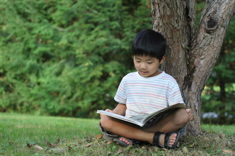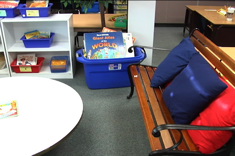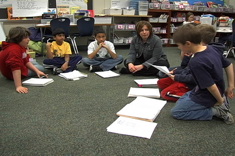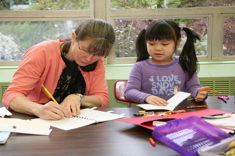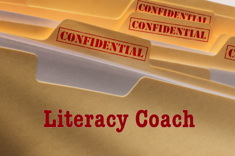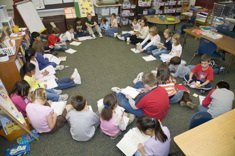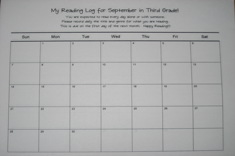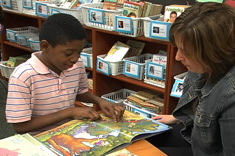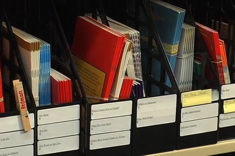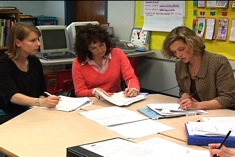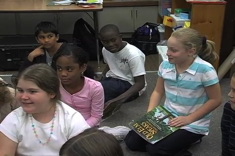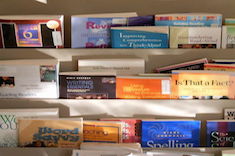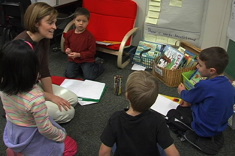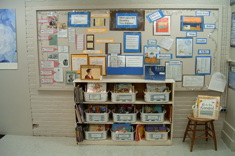Articles
Here is where you’ll find all the latest print features from our contributors. If you’d like to browse specifically by grade level, topic, or contributor, you can use the links in the right sidebar.
Latest Content
Going from the Known to the Unknown: Vacation Reflections on Fluency
Jennifer Jones uses her experience as a tourist in a Spanish-speaking country to consider how fluency and meaning are (and aren't) connected, and what that means for teaching students.
Back to the Classroom
Shari Frost reflects on what went wrong (or right) when a literacy coach decides to return to the classroom, and in doing so considers the kind of support literacy coaches need to thrive.
Knitting, Independence, and Small Group Routines for Intermediate Readers
Franki Sibberson uses a knitting analogy to reflect upon alternatives to guided reading in the intermediate grades that promote more student independence.
Build Fluency with Books That Are Fun for Kids to Read Aloud Over and Over and Over Again
Here’s a booklist of delightful titles that will build fluency skills for students — both as read alouds, and during independent reading.
Selecting Texts for Strategy Teaching with English Language Learners in Mind
Text selection for English language learners poses special challenges. Clare Landrigan and Tammy Mulligan explain how the criteria for “just-right books” are different for ELLs, and provide practical examples of how teachers use these principles of book selection in their classrooms.
Literacy Coach Confidential: My Colleague Talks Too Much!
Yakity yak won't bring 'em back to study groups when someone talks far too much. Here is advice from Choice Literacy contributors on how to deal with those "overtalkers" with tact and grace.
Reflections on Our Year of Read Alouds (BOOKLIST)
if you're moving from thinking about read alouds for the first days of school, to plotting out a plan for read alouds all year long, you might want to read Franki Sibberson's booklist of read-alouds used for the entire year with her 3rd and 4th grade students.
Lessons from My Summer Vacation
Erin Ocon finds it's hard to let go of her planning and perfectionism as she rewrites her goals for the summer. In "Lessons from My Summer Vacation," she discovers the process of changing her summer plans makes her rethink her classroom goals.
How Can School and Classroom Libraries Support Struggling Readers?
Franki Sibberson tries to imagine what school and classroom libraries look like to struggling readers who are gazing at scores of books beyond their reading levels.
What Reading is Like: Sports Analogies to Use with Parents
Clare Landrigan and Tammy Mulligan provide some sports analogies to share with families when talking about reading growth. The article includes a handout of prompts parents can use to spark discussions about books with their children.
A Reason to Learn
Jennifer Allen reflects on why and how literacy leaders need to make their professional development offerings more relevant and rigorous for teachers.
Conversation Turns: Recordkeeping and Analysis Tool
Suzy Kaback provides a template for helping students note and reflect upon their talk.
What Happens Next
"What Happens Next" from Shirl McPhillips is a poem celebrating the renewal that comes when spring finally arrives – a perfect metaphor for the different seasons of the school year.
Rethinking Reading at Home
What’s the value of reading at home? Mandy Robek ponders the home/school connection. Download a copy of a rubric to assess the home reading log.
Literacy Builds Community: The Jackdaw Project
"School is not summer camp" – this quote reminds Mandy Robek that there are many challenges to building a strong classroom community in the midst of demands for achievement and accountability early in the year. Her "literacy jackdaw" project is a terrific vehicle for classmates to learn about each other, and hone their listening, speaking, and writing skills in the process.
Student Independence and Ownership in the Library
The “status of the class” form is a tool used by many teachers in reading and writing workshops to chart student plans daily. As Franki Sibberson tests out a status form in the school library, she discovers it has more value than she realized.
Community First: Using Read Alouds to Strengthen Classroom Connections
Mary Lee Hahn plans her read alouds for double duty, using them to build the community and a love of reading.
Letters in the Middle School Classroom
First-year teacher Erin Ocon finds an old-fashioned way to build rapport with some of her struggling middle school students – she writes letters to them. This brief article would be a good reading for a middle school team meeting or new teacher group.
Read Our Walls: Bridging Professional Development and Student Achievement
Jennifer Allen and her colleagues knew test scores weren’t the only way of defining their students’ achievements and the value of their professional development program. “Read Our Walls” is an easy but powerful way to celebrate writing from the entire school community.
Books for Phonics Instruction – Accomplishing More Than Just Sounding Out Words
Shari Frost finds herself appalled at some of the "books" children are reading in the name of phonics instruction, so she sets out to create a booklist of high quality children's literature that does more than just help children sound out words.
From Congeniality to Collegiality: Protocols for Meetings and Observations
Clare Landrigan and Tammy Mulligan suggest a few tested and successful protocols for meetings and study groups that foster more thoughtful conversations.
What My Son’s Reading Difficulties Taught Me About Teaching Struggling Readers
No matter how many education methods courses and professional development workshops you take, if you’re a parent, your children will always teach you the most about how students learn. Tammy Mulligan shares three practical strategies for reaching struggling readers that she learned from experiences with her son.
From “Data Drowning” to “Data Wise”: What Are We Doing Now?
Clare Landrigan and Tammy Mulligan provide an activity for staff meetings designed to help schools sort through the purpose and value of current assessments.
More Teaching Metaphors
Ruth Shagoury considers her struggles with "beginner's mind" in yoga and mountain biking, and what they can both teach her about students who are struggling with any new learning.
Getting the Most Out of Picture Books
If you are a fan of Mo Willems’ picture books (and who isn’t?), you’ll enjoy Katie DiCesare’s ideas for integrating his popular stories throughout the literacy curriculum. From read-alouds to mentor texts, these books are wonderful tools for engaging students.
Bucking Broncs and Spitting Bulls
Andie Cunningham finds a rodeo reminds her of the opening days of school, and how timed assessments can cloud our vision of students early in the year.
Using Poetry to Promote Reading Fluency
Aimee Buckner shares how to use a mentor text to build fluency through poetry.
Building a Professional Library from Scratch
There are so many new professional books available for literacy leaders to purchase…and so little funding to buy them. Shari Frost gives the details of how one coach surveyed colleagues, assessed needs, and rooted out bargains before spending the precious $500 allocated for stocking the professional book library.
Step by Step: Integrating Nonfiction into Primary Classroom Instruction
Nonfiction texts require different reading skills than fiction, and you can’t introduce nonfiction genres to children too early. Katie DiCesare shares how she moves between whole-class, small-group, and individual instruction to help all her first graders master the text features in nonfiction.
Rethinking a Study of Nonfiction Writing
Franki Sibberson reflects on her nonfiction writing unit, and realizes she emphasizes research skills at the expense of the craft of nonfiction writing.
Browse Content By
Type
Category
- Assessment Tools
- Big Fresh Archives
- Booklists
- Choice Numeracy
- Classroom Design
- Common Core
- Community Building
- Conferring
- Content Literacy
- Digital Literacy
- English Language Learners
- Equity
- Family Relations
- Free Samples
- Guiding Groups
- Leadership
- Literacy Coaches
- Mentor Texts
- Minilessons
- New Teacher Mentors
- Podcasts
- Poetry
- Quote Collections
- Reading Strategies
- Self Care
- Struggling and Striving Learners
- Talking and Listening
- Teacher Study Groups
- Teaching Reading
- Teaching Writing
- Word Study and Vocabulary
Author
- Melissa Quimby
- Nawal Qarooni
- Gwen Blumberg
- Julie Cox
- The Lead Learners
- Hannah Tills
- Josie Stewart
- Ruth Metcalfe
- Mallory Messenger
- Becca Burk
- Jodie Bailey
- Vivian Chen
- Mary Brower
- Tiffany Abbott Fuller
- Stephanie Affinito
- Ruth Ayres
- Leigh Anne Eck
- Heather Fisher
- Shari Frost
- Julie Johnson
- Suzy Kaback
- Gigi McAllister
- Shirl McPhillips
- Melanie Meehan
- Cathy Mere
- Debbie Miller
- Tara Barnett and Kate Mills
- Tammy Mulligan
- Dana Murphy
- Bitsy Parks
- David Pittman
- Brenda Power
- Heather Rader
- Matt Renwick
- Mandy Robek
- Christy Rush-Levine
- Gretchen Schroeder
- Jen Schwanke
- Brian Sepe
- Katherine Sokolowski
- Stella Villalba
- Jennifer Vincent
Grade Level
Choice Literacy Membership
Articles
Get full access to all Choice Literacy article content
Videos
Get full access to all Choice Literacy video content
Courses
Access Choice Literacy course curriculum and training

